NUR1102: Analysis of Communication in Aged Care Scenario Report
VerifiedAdded on 2023/01/10
|8
|1909
|84
Report
AI Summary
This report analyzes a communication scenario in an aged care facility involving a nursing student and a patient with vascular dementia. It applies the concept of person-centered care and examines effective communication during clinical handover, highlighting the importance of clear communication between nurses. The report identifies ineffective communication statements and emphasizes the need for standardized communication tools and frameworks to ensure patient safety and improve care. It explores nursing communication tools like charting books and verbal communication, and emphasizes the significance of strong interpersonal relationships between nurses and patients. The report concludes by stressing the need for good communication skills, teamwork, and effective patient care strategies to mitigate risks and improve patient outcomes. The assignment also includes forum posts related to the topic.
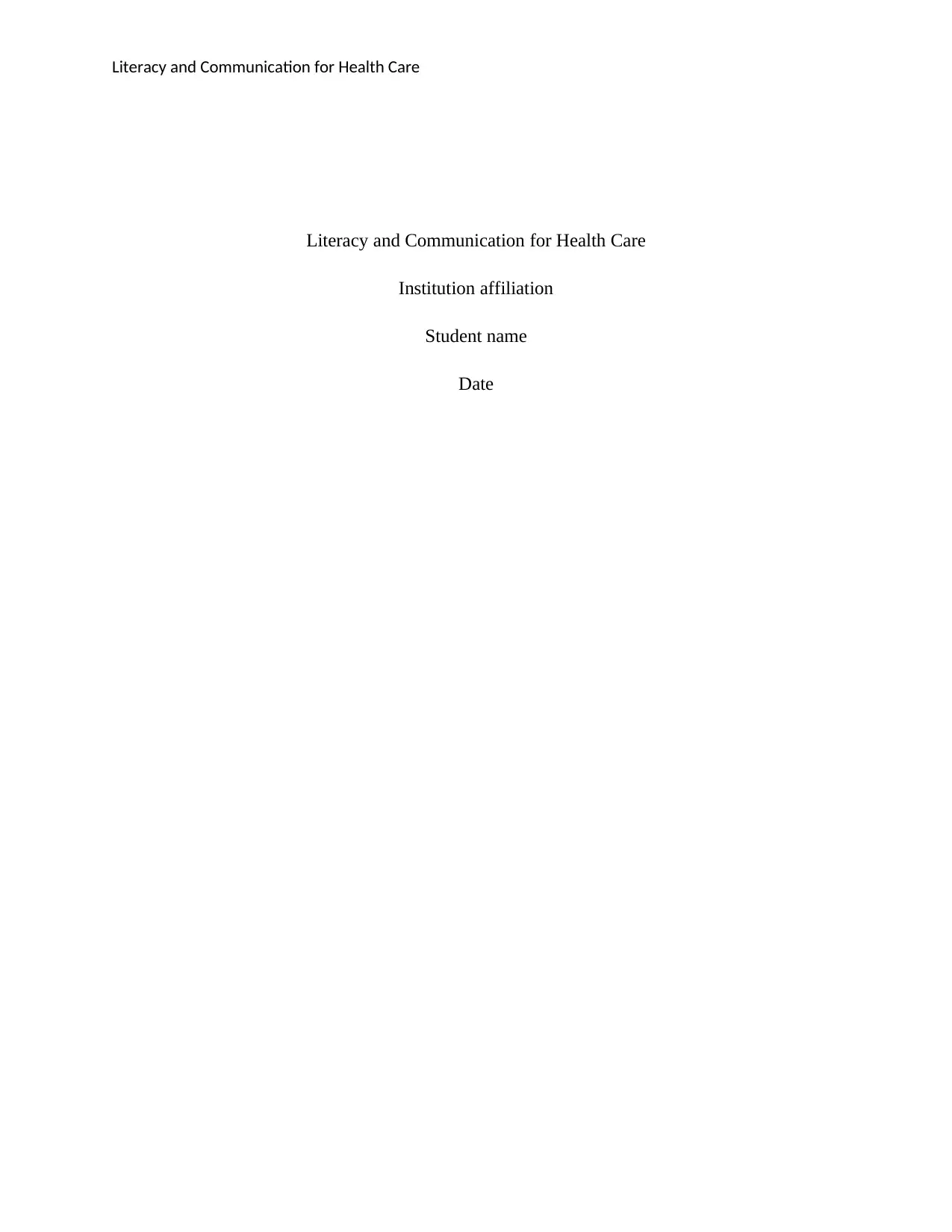
Literacy and Communication for Health Care
Literacy and Communication for Health Care
Institution affiliation
Student name
Date
Literacy and Communication for Health Care
Institution affiliation
Student name
Date
Paraphrase This Document
Need a fresh take? Get an instant paraphrase of this document with our AI Paraphraser
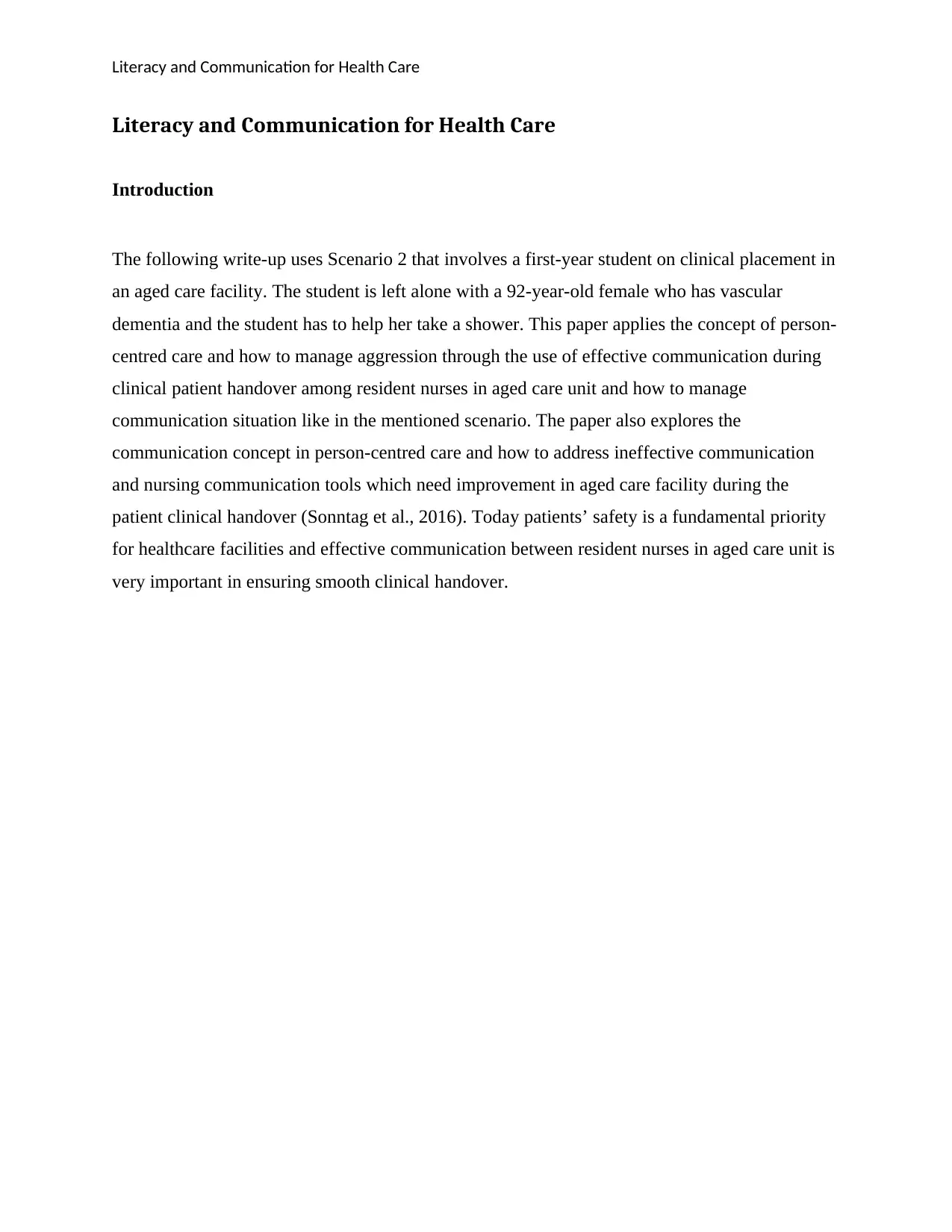
Literacy and Communication for Health Care
Literacy and Communication for Health Care
Introduction
The following write-up uses Scenario 2 that involves a first-year student on clinical placement in
an aged care facility. The student is left alone with a 92-year-old female who has vascular
dementia and the student has to help her take a shower. This paper applies the concept of person-
centred care and how to manage aggression through the use of effective communication during
clinical patient handover among resident nurses in aged care unit and how to manage
communication situation like in the mentioned scenario. The paper also explores the
communication concept in person-centred care and how to address ineffective communication
and nursing communication tools which need improvement in aged care facility during the
patient clinical handover (Sonntag et al., 2016). Today patients’ safety is a fundamental priority
for healthcare facilities and effective communication between resident nurses in aged care unit is
very important in ensuring smooth clinical handover.
Literacy and Communication for Health Care
Introduction
The following write-up uses Scenario 2 that involves a first-year student on clinical placement in
an aged care facility. The student is left alone with a 92-year-old female who has vascular
dementia and the student has to help her take a shower. This paper applies the concept of person-
centred care and how to manage aggression through the use of effective communication during
clinical patient handover among resident nurses in aged care unit and how to manage
communication situation like in the mentioned scenario. The paper also explores the
communication concept in person-centred care and how to address ineffective communication
and nursing communication tools which need improvement in aged care facility during the
patient clinical handover (Sonntag et al., 2016). Today patients’ safety is a fundamental priority
for healthcare facilities and effective communication between resident nurses in aged care unit is
very important in ensuring smooth clinical handover.
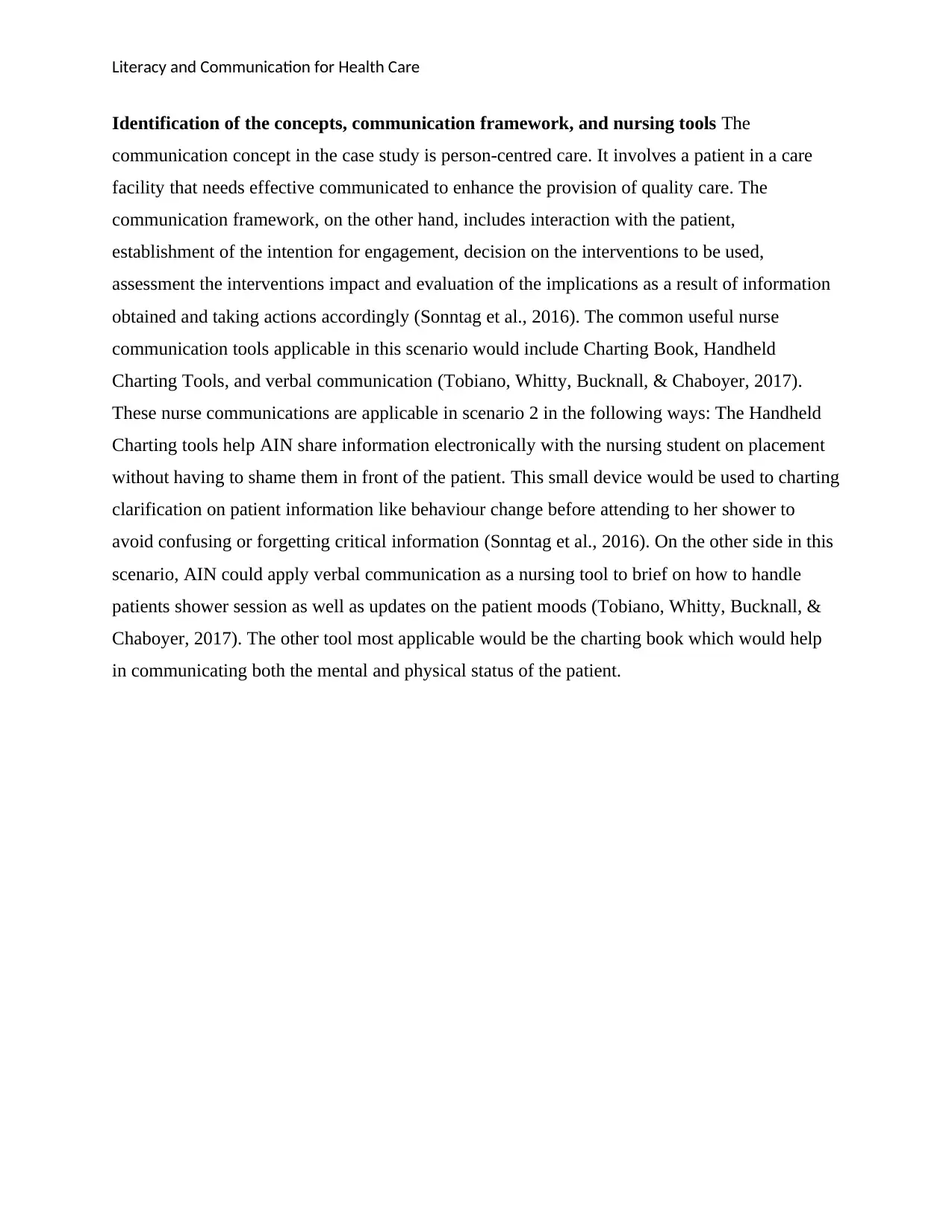
Literacy and Communication for Health Care
Identification of the concepts, communication framework, and nursing tools The
communication concept in the case study is person-centred care. It involves a patient in a care
facility that needs effective communicated to enhance the provision of quality care. The
communication framework, on the other hand, includes interaction with the patient,
establishment of the intention for engagement, decision on the interventions to be used,
assessment the interventions impact and evaluation of the implications as a result of information
obtained and taking actions accordingly (Sonntag et al., 2016). The common useful nurse
communication tools applicable in this scenario would include Charting Book, Handheld
Charting Tools, and verbal communication (Tobiano, Whitty, Bucknall, & Chaboyer, 2017).
These nurse communications are applicable in scenario 2 in the following ways: The Handheld
Charting tools help AIN share information electronically with the nursing student on placement
without having to shame them in front of the patient. This small device would be used to charting
clarification on patient information like behaviour change before attending to her shower to
avoid confusing or forgetting critical information (Sonntag et al., 2016). On the other side in this
scenario, AIN could apply verbal communication as a nursing tool to brief on how to handle
patients shower session as well as updates on the patient moods (Tobiano, Whitty, Bucknall, &
Chaboyer, 2017). The other tool most applicable would be the charting book which would help
in communicating both the mental and physical status of the patient.
Identification of the concepts, communication framework, and nursing tools The
communication concept in the case study is person-centred care. It involves a patient in a care
facility that needs effective communicated to enhance the provision of quality care. The
communication framework, on the other hand, includes interaction with the patient,
establishment of the intention for engagement, decision on the interventions to be used,
assessment the interventions impact and evaluation of the implications as a result of information
obtained and taking actions accordingly (Sonntag et al., 2016). The common useful nurse
communication tools applicable in this scenario would include Charting Book, Handheld
Charting Tools, and verbal communication (Tobiano, Whitty, Bucknall, & Chaboyer, 2017).
These nurse communications are applicable in scenario 2 in the following ways: The Handheld
Charting tools help AIN share information electronically with the nursing student on placement
without having to shame them in front of the patient. This small device would be used to charting
clarification on patient information like behaviour change before attending to her shower to
avoid confusing or forgetting critical information (Sonntag et al., 2016). On the other side in this
scenario, AIN could apply verbal communication as a nursing tool to brief on how to handle
patients shower session as well as updates on the patient moods (Tobiano, Whitty, Bucknall, &
Chaboyer, 2017). The other tool most applicable would be the charting book which would help
in communicating both the mental and physical status of the patient.
⊘ This is a preview!⊘
Do you want full access?
Subscribe today to unlock all pages.

Trusted by 1+ million students worldwide
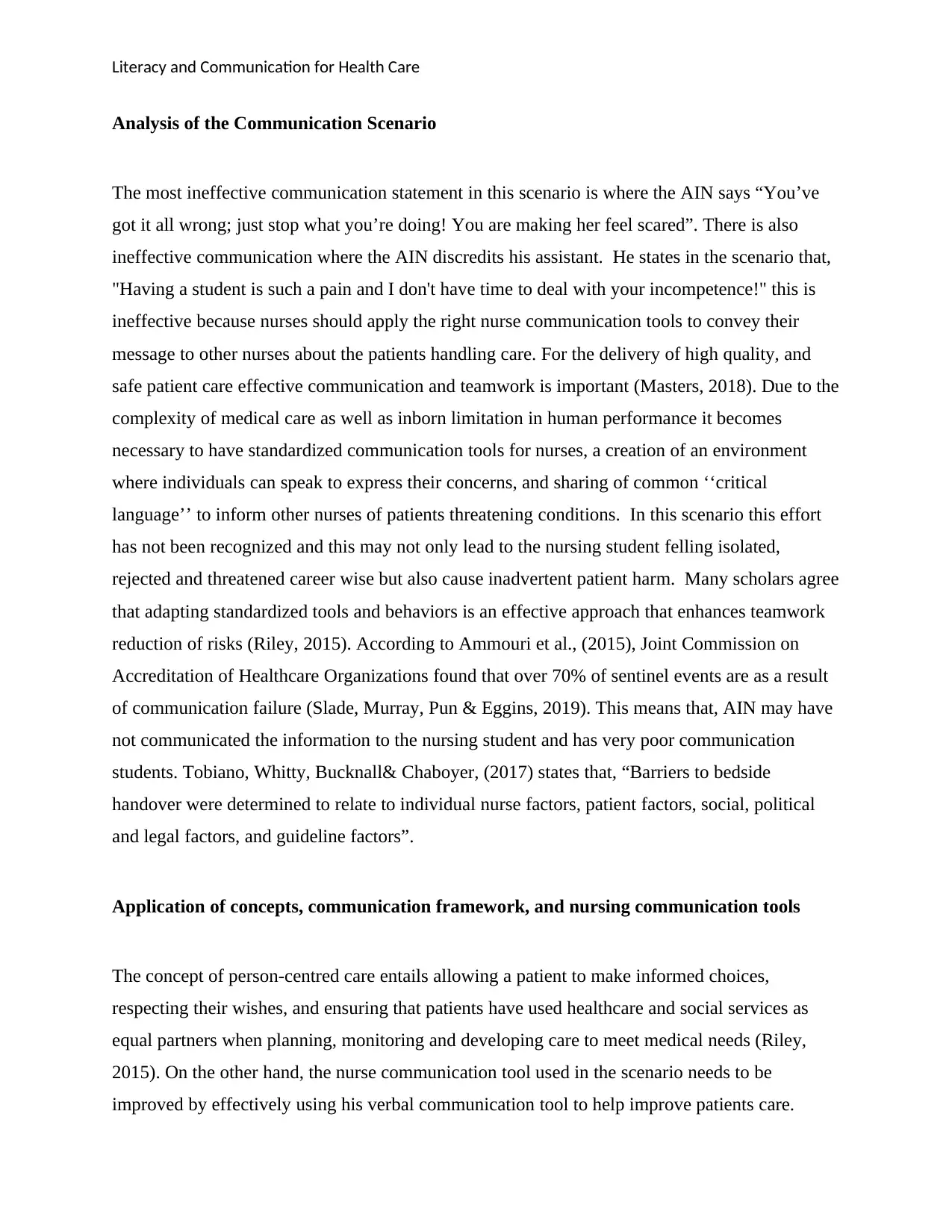
Literacy and Communication for Health Care
Analysis of the Communication Scenario
The most ineffective communication statement in this scenario is where the AIN says “You’ve
got it all wrong; just stop what you’re doing! You are making her feel scared”. There is also
ineffective communication where the AIN discredits his assistant. He states in the scenario that,
"Having a student is such a pain and I don't have time to deal with your incompetence!" this is
ineffective because nurses should apply the right nurse communication tools to convey their
message to other nurses about the patients handling care. For the delivery of high quality, and
safe patient care effective communication and teamwork is important (Masters, 2018). Due to the
complexity of medical care as well as inborn limitation in human performance it becomes
necessary to have standardized communication tools for nurses, a creation of an environment
where individuals can speak to express their concerns, and sharing of common ‘‘critical
language’’ to inform other nurses of patients threatening conditions. In this scenario this effort
has not been recognized and this may not only lead to the nursing student felling isolated,
rejected and threatened career wise but also cause inadvertent patient harm. Many scholars agree
that adapting standardized tools and behaviors is an effective approach that enhances teamwork
reduction of risks (Riley, 2015). According to Ammouri et al., (2015), Joint Commission on
Accreditation of Healthcare Organizations found that over 70% of sentinel events are as a result
of communication failure (Slade, Murray, Pun & Eggins, 2019). This means that, AIN may have
not communicated the information to the nursing student and has very poor communication
students. Tobiano, Whitty, Bucknall& Chaboyer, (2017) states that, “Barriers to bedside
handover were determined to relate to individual nurse factors, patient factors, social, political
and legal factors, and guideline factors”.
Application of concepts, communication framework, and nursing communication tools
The concept of person-centred care entails allowing a patient to make informed choices,
respecting their wishes, and ensuring that patients have used healthcare and social services as
equal partners when planning, monitoring and developing care to meet medical needs (Riley,
2015). On the other hand, the nurse communication tool used in the scenario needs to be
improved by effectively using his verbal communication tool to help improve patients care.
Analysis of the Communication Scenario
The most ineffective communication statement in this scenario is where the AIN says “You’ve
got it all wrong; just stop what you’re doing! You are making her feel scared”. There is also
ineffective communication where the AIN discredits his assistant. He states in the scenario that,
"Having a student is such a pain and I don't have time to deal with your incompetence!" this is
ineffective because nurses should apply the right nurse communication tools to convey their
message to other nurses about the patients handling care. For the delivery of high quality, and
safe patient care effective communication and teamwork is important (Masters, 2018). Due to the
complexity of medical care as well as inborn limitation in human performance it becomes
necessary to have standardized communication tools for nurses, a creation of an environment
where individuals can speak to express their concerns, and sharing of common ‘‘critical
language’’ to inform other nurses of patients threatening conditions. In this scenario this effort
has not been recognized and this may not only lead to the nursing student felling isolated,
rejected and threatened career wise but also cause inadvertent patient harm. Many scholars agree
that adapting standardized tools and behaviors is an effective approach that enhances teamwork
reduction of risks (Riley, 2015). According to Ammouri et al., (2015), Joint Commission on
Accreditation of Healthcare Organizations found that over 70% of sentinel events are as a result
of communication failure (Slade, Murray, Pun & Eggins, 2019). This means that, AIN may have
not communicated the information to the nursing student and has very poor communication
students. Tobiano, Whitty, Bucknall& Chaboyer, (2017) states that, “Barriers to bedside
handover were determined to relate to individual nurse factors, patient factors, social, political
and legal factors, and guideline factors”.
Application of concepts, communication framework, and nursing communication tools
The concept of person-centred care entails allowing a patient to make informed choices,
respecting their wishes, and ensuring that patients have used healthcare and social services as
equal partners when planning, monitoring and developing care to meet medical needs (Riley,
2015). On the other hand, the nurse communication tool used in the scenario needs to be
improved by effectively using his verbal communication tool to help improve patients care.
Paraphrase This Document
Need a fresh take? Get an instant paraphrase of this document with our AI Paraphraser
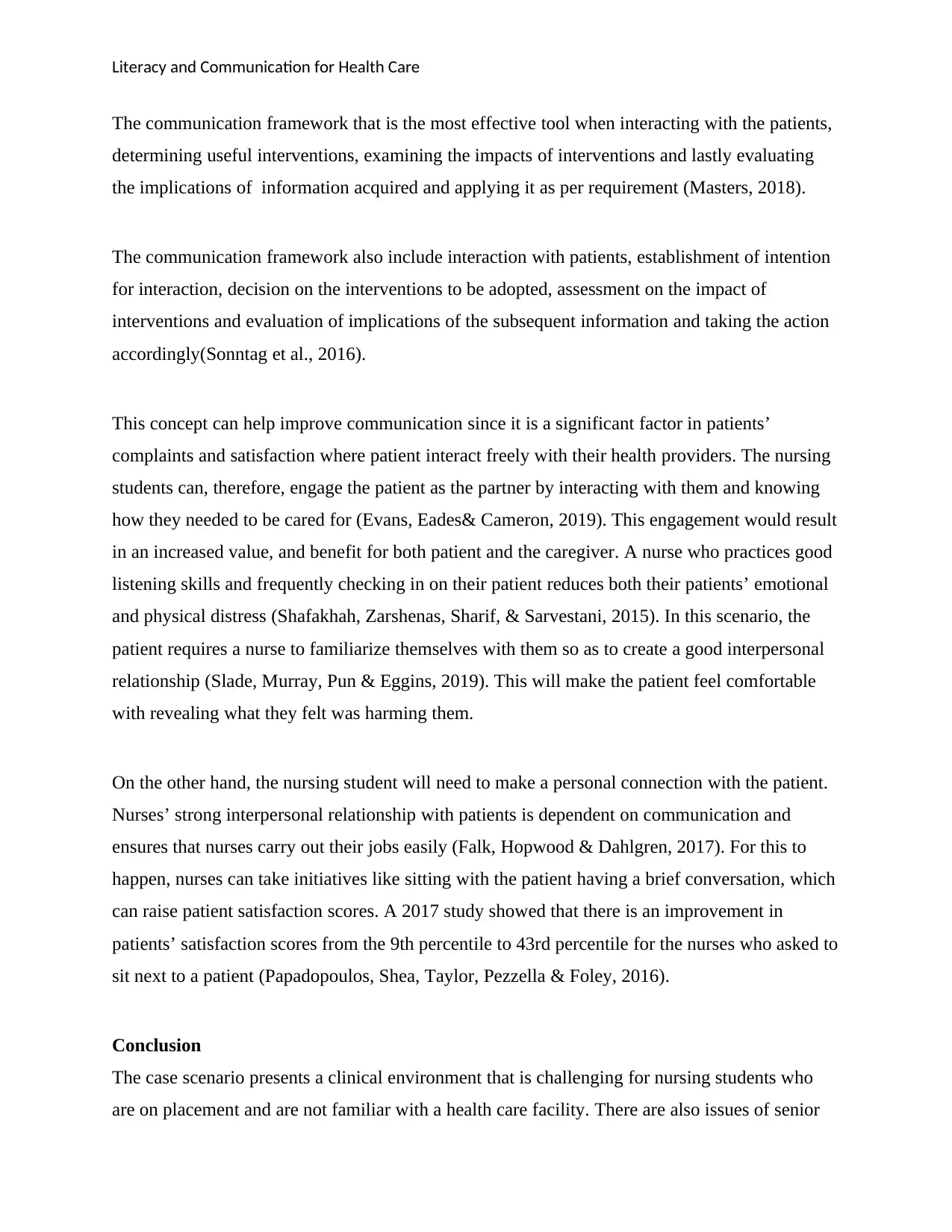
Literacy and Communication for Health Care
The communication framework that is the most effective tool when interacting with the patients,
determining useful interventions, examining the impacts of interventions and lastly evaluating
the implications of information acquired and applying it as per requirement (Masters, 2018).
The communication framework also include interaction with patients, establishment of intention
for interaction, decision on the interventions to be adopted, assessment on the impact of
interventions and evaluation of implications of the subsequent information and taking the action
accordingly(Sonntag et al., 2016).
This concept can help improve communication since it is a significant factor in patients’
complaints and satisfaction where patient interact freely with their health providers. The nursing
students can, therefore, engage the patient as the partner by interacting with them and knowing
how they needed to be cared for (Evans, Eades& Cameron, 2019). This engagement would result
in an increased value, and benefit for both patient and the caregiver. A nurse who practices good
listening skills and frequently checking in on their patient reduces both their patients’ emotional
and physical distress (Shafakhah, Zarshenas, Sharif, & Sarvestani, 2015). In this scenario, the
patient requires a nurse to familiarize themselves with them so as to create a good interpersonal
relationship (Slade, Murray, Pun & Eggins, 2019). This will make the patient feel comfortable
with revealing what they felt was harming them.
On the other hand, the nursing student will need to make a personal connection with the patient.
Nurses’ strong interpersonal relationship with patients is dependent on communication and
ensures that nurses carry out their jobs easily (Falk, Hopwood & Dahlgren, 2017). For this to
happen, nurses can take initiatives like sitting with the patient having a brief conversation, which
can raise patient satisfaction scores. A 2017 study showed that there is an improvement in
patients’ satisfaction scores from the 9th percentile to 43rd percentile for the nurses who asked to
sit next to a patient (Papadopoulos, Shea, Taylor, Pezzella & Foley, 2016).
Conclusion
The case scenario presents a clinical environment that is challenging for nursing students who
are on placement and are not familiar with a health care facility. There are also issues of senior
The communication framework that is the most effective tool when interacting with the patients,
determining useful interventions, examining the impacts of interventions and lastly evaluating
the implications of information acquired and applying it as per requirement (Masters, 2018).
The communication framework also include interaction with patients, establishment of intention
for interaction, decision on the interventions to be adopted, assessment on the impact of
interventions and evaluation of implications of the subsequent information and taking the action
accordingly(Sonntag et al., 2016).
This concept can help improve communication since it is a significant factor in patients’
complaints and satisfaction where patient interact freely with their health providers. The nursing
students can, therefore, engage the patient as the partner by interacting with them and knowing
how they needed to be cared for (Evans, Eades& Cameron, 2019). This engagement would result
in an increased value, and benefit for both patient and the caregiver. A nurse who practices good
listening skills and frequently checking in on their patient reduces both their patients’ emotional
and physical distress (Shafakhah, Zarshenas, Sharif, & Sarvestani, 2015). In this scenario, the
patient requires a nurse to familiarize themselves with them so as to create a good interpersonal
relationship (Slade, Murray, Pun & Eggins, 2019). This will make the patient feel comfortable
with revealing what they felt was harming them.
On the other hand, the nursing student will need to make a personal connection with the patient.
Nurses’ strong interpersonal relationship with patients is dependent on communication and
ensures that nurses carry out their jobs easily (Falk, Hopwood & Dahlgren, 2017). For this to
happen, nurses can take initiatives like sitting with the patient having a brief conversation, which
can raise patient satisfaction scores. A 2017 study showed that there is an improvement in
patients’ satisfaction scores from the 9th percentile to 43rd percentile for the nurses who asked to
sit next to a patient (Papadopoulos, Shea, Taylor, Pezzella & Foley, 2016).
Conclusion
The case scenario presents a clinical environment that is challenging for nursing students who
are on placement and are not familiar with a health care facility. There are also issues of senior
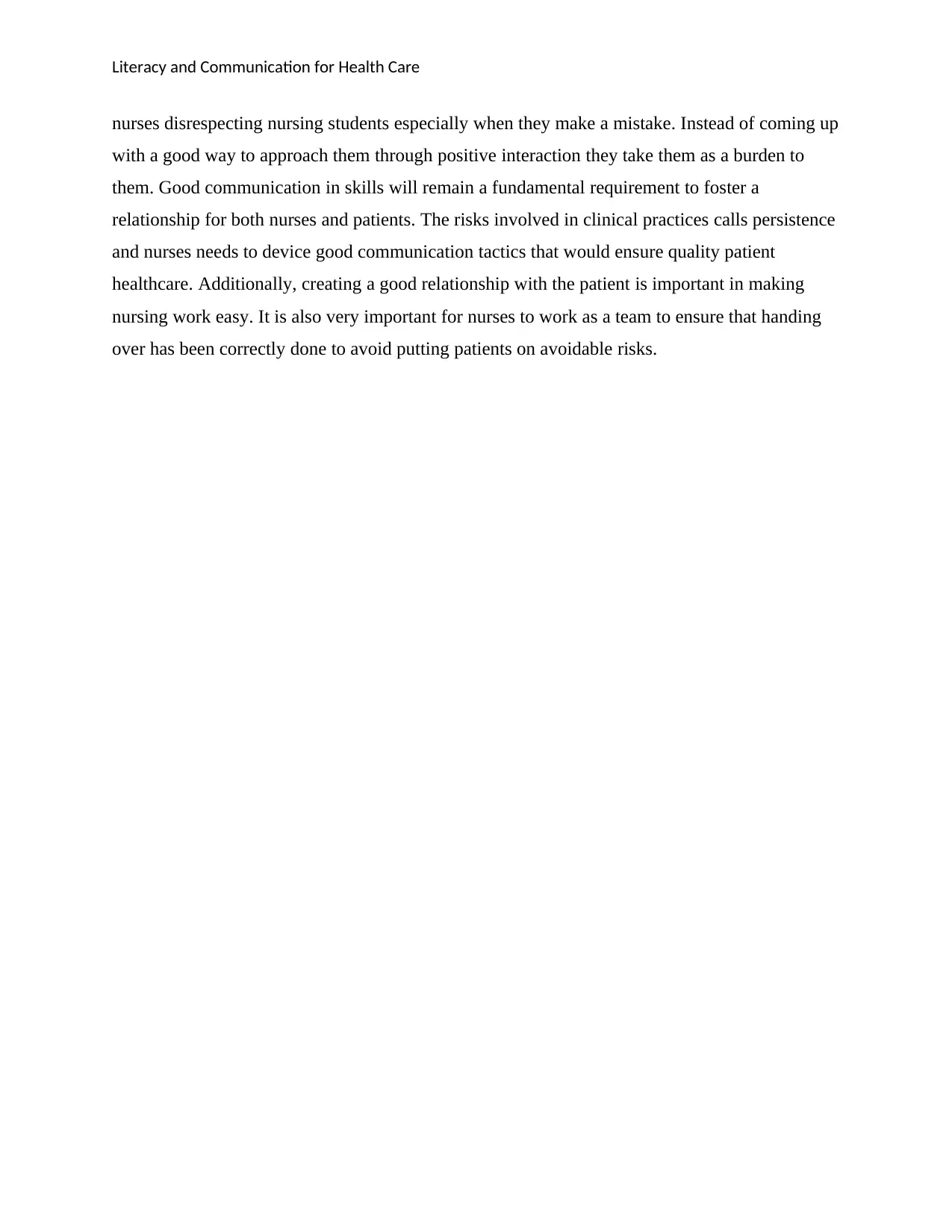
Literacy and Communication for Health Care
nurses disrespecting nursing students especially when they make a mistake. Instead of coming up
with a good way to approach them through positive interaction they take them as a burden to
them. Good communication in skills will remain a fundamental requirement to foster a
relationship for both nurses and patients. The risks involved in clinical practices calls persistence
and nurses needs to device good communication tactics that would ensure quality patient
healthcare. Additionally, creating a good relationship with the patient is important in making
nursing work easy. It is also very important for nurses to work as a team to ensure that handing
over has been correctly done to avoid putting patients on avoidable risks.
nurses disrespecting nursing students especially when they make a mistake. Instead of coming up
with a good way to approach them through positive interaction they take them as a burden to
them. Good communication in skills will remain a fundamental requirement to foster a
relationship for both nurses and patients. The risks involved in clinical practices calls persistence
and nurses needs to device good communication tactics that would ensure quality patient
healthcare. Additionally, creating a good relationship with the patient is important in making
nursing work easy. It is also very important for nurses to work as a team to ensure that handing
over has been correctly done to avoid putting patients on avoidable risks.
⊘ This is a preview!⊘
Do you want full access?
Subscribe today to unlock all pages.

Trusted by 1+ million students worldwide
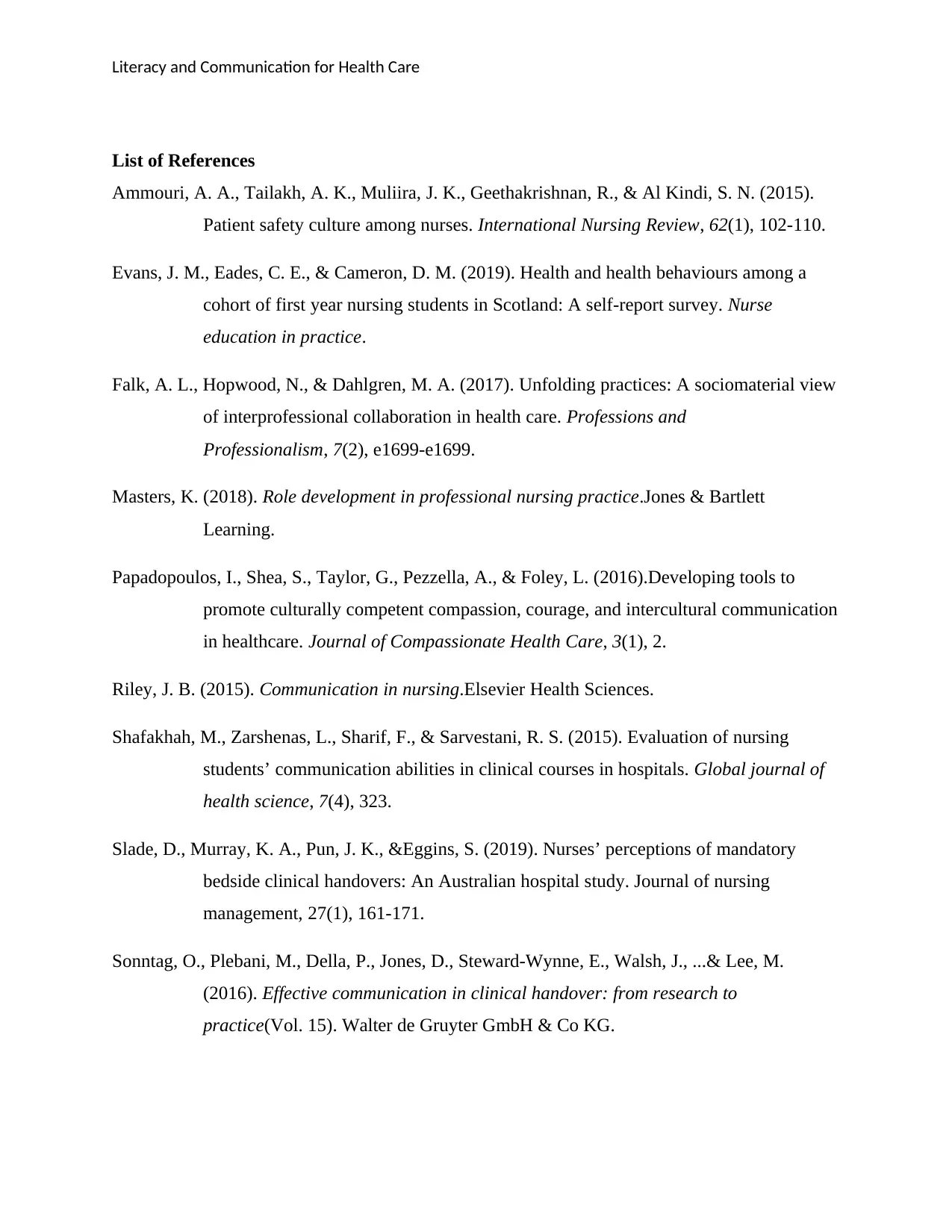
Literacy and Communication for Health Care
List of References
Ammouri, A. A., Tailakh, A. K., Muliira, J. K., Geethakrishnan, R., & Al Kindi, S. N. (2015).
Patient safety culture among nurses. International Nursing Review, 62(1), 102-110.
Evans, J. M., Eades, C. E., & Cameron, D. M. (2019). Health and health behaviours among a
cohort of first year nursing students in Scotland: A self-report survey. Nurse
education in practice.
Falk, A. L., Hopwood, N., & Dahlgren, M. A. (2017). Unfolding practices: A sociomaterial view
of interprofessional collaboration in health care. Professions and
Professionalism, 7(2), e1699-e1699.
Masters, K. (2018). Role development in professional nursing practice.Jones & Bartlett
Learning.
Papadopoulos, I., Shea, S., Taylor, G., Pezzella, A., & Foley, L. (2016).Developing tools to
promote culturally competent compassion, courage, and intercultural communication
in healthcare. Journal of Compassionate Health Care, 3(1), 2.
Riley, J. B. (2015). Communication in nursing.Elsevier Health Sciences.
Shafakhah, M., Zarshenas, L., Sharif, F., & Sarvestani, R. S. (2015). Evaluation of nursing
students’ communication abilities in clinical courses in hospitals. Global journal of
health science, 7(4), 323.
Slade, D., Murray, K. A., Pun, J. K., &Eggins, S. (2019). Nurses’ perceptions of mandatory
bedside clinical handovers: An Australian hospital study. Journal of nursing
management, 27(1), 161-171.
Sonntag, O., Plebani, M., Della, P., Jones, D., Steward-Wynne, E., Walsh, J., ...& Lee, M.
(2016). Effective communication in clinical handover: from research to
practice(Vol. 15). Walter de Gruyter GmbH & Co KG.
List of References
Ammouri, A. A., Tailakh, A. K., Muliira, J. K., Geethakrishnan, R., & Al Kindi, S. N. (2015).
Patient safety culture among nurses. International Nursing Review, 62(1), 102-110.
Evans, J. M., Eades, C. E., & Cameron, D. M. (2019). Health and health behaviours among a
cohort of first year nursing students in Scotland: A self-report survey. Nurse
education in practice.
Falk, A. L., Hopwood, N., & Dahlgren, M. A. (2017). Unfolding practices: A sociomaterial view
of interprofessional collaboration in health care. Professions and
Professionalism, 7(2), e1699-e1699.
Masters, K. (2018). Role development in professional nursing practice.Jones & Bartlett
Learning.
Papadopoulos, I., Shea, S., Taylor, G., Pezzella, A., & Foley, L. (2016).Developing tools to
promote culturally competent compassion, courage, and intercultural communication
in healthcare. Journal of Compassionate Health Care, 3(1), 2.
Riley, J. B. (2015). Communication in nursing.Elsevier Health Sciences.
Shafakhah, M., Zarshenas, L., Sharif, F., & Sarvestani, R. S. (2015). Evaluation of nursing
students’ communication abilities in clinical courses in hospitals. Global journal of
health science, 7(4), 323.
Slade, D., Murray, K. A., Pun, J. K., &Eggins, S. (2019). Nurses’ perceptions of mandatory
bedside clinical handovers: An Australian hospital study. Journal of nursing
management, 27(1), 161-171.
Sonntag, O., Plebani, M., Della, P., Jones, D., Steward-Wynne, E., Walsh, J., ...& Lee, M.
(2016). Effective communication in clinical handover: from research to
practice(Vol. 15). Walter de Gruyter GmbH & Co KG.
Paraphrase This Document
Need a fresh take? Get an instant paraphrase of this document with our AI Paraphraser
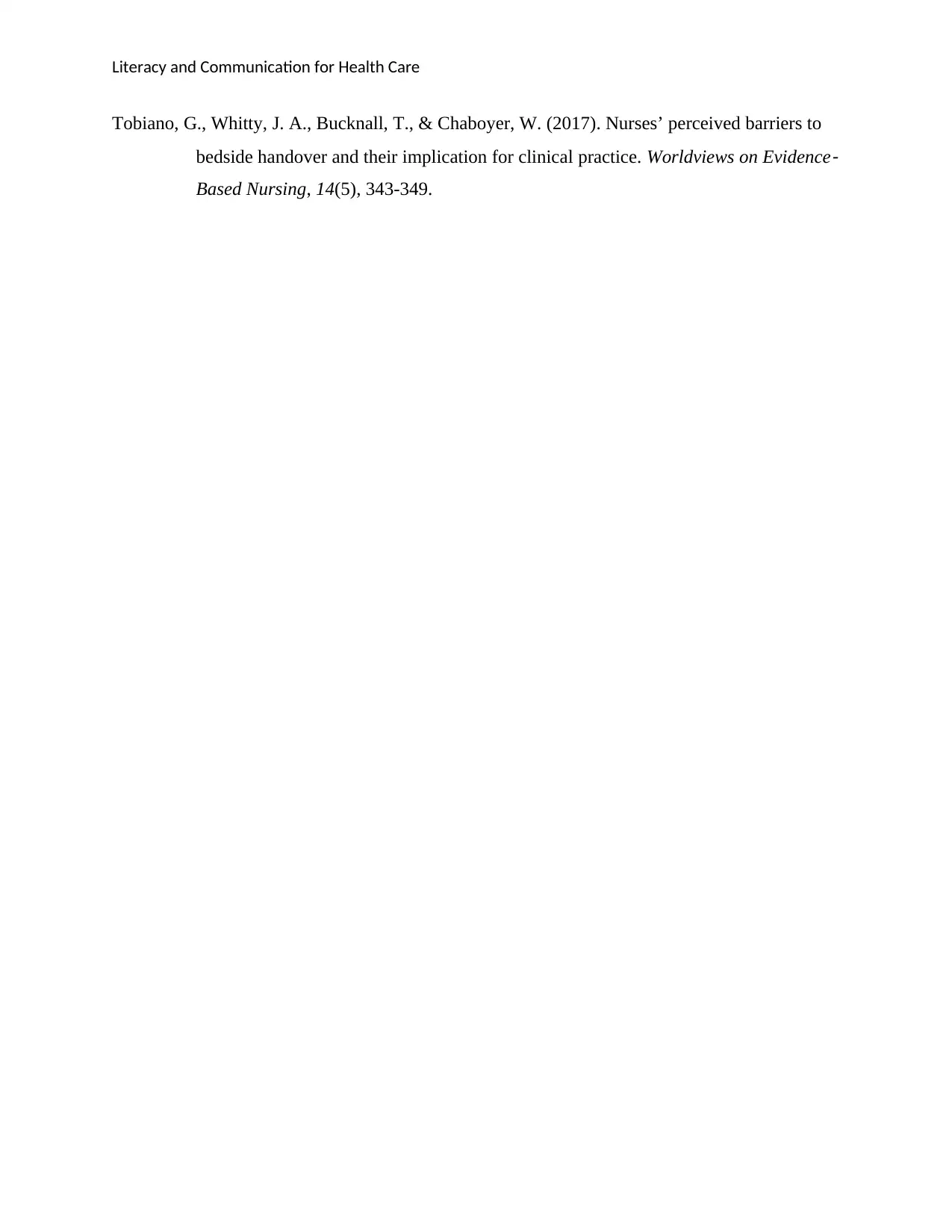
Literacy and Communication for Health Care
Tobiano, G., Whitty, J. A., Bucknall, T., & Chaboyer, W. (2017). Nurses’ perceived barriers to
bedside handover and their implication for clinical practice. Worldviews on Evidence
‐
Based Nursing, 14(5), 343-349.
Tobiano, G., Whitty, J. A., Bucknall, T., & Chaboyer, W. (2017). Nurses’ perceived barriers to
bedside handover and their implication for clinical practice. Worldviews on Evidence
‐
Based Nursing, 14(5), 343-349.
1 out of 8
Related Documents
Your All-in-One AI-Powered Toolkit for Academic Success.
+13062052269
info@desklib.com
Available 24*7 on WhatsApp / Email
![[object Object]](/_next/static/media/star-bottom.7253800d.svg)
Unlock your academic potential
Copyright © 2020–2025 A2Z Services. All Rights Reserved. Developed and managed by ZUCOL.





